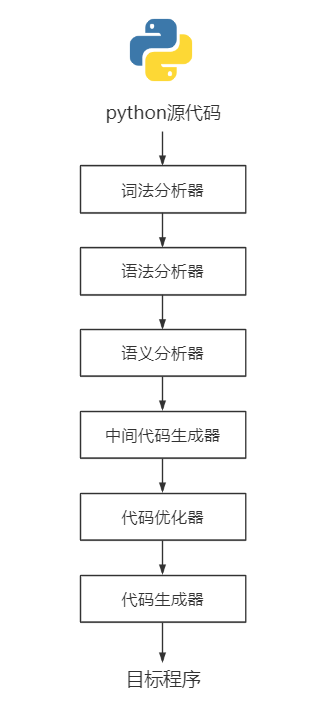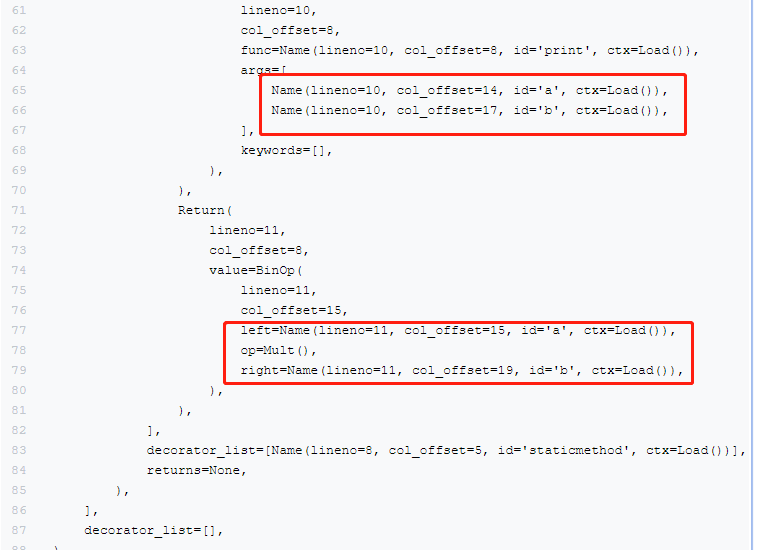不要再手动批量替换了,使用 python AST 模块批量替换

前言
在我们日常协作开发时,在团队内没有良好的规范或者 code review 机制时,经常会出现使用语义不明的变量,比如 a、b、c 等,使得代码可读性非常差,如果要将变量变更为具有语义的变量,批量替换容易替换错,而挨个手动替换也容易遗漏或者出错,因此,需要寻找快捷准确的方式处理这种情况。本文我们只针对 python 语言,首先我们先来了解一下 python 语言的编译过程。
我们整天和代码打交道,都知道高级语言分为解释型语言和编译型语言。解释型语言通过相应的解释器,将源代码翻译成目标代码(机器语言,也就是二进制形式),边解释边执行,因为边解释边执行的特点,因此执行效率比较低,且运行时不能脱离解释器;编译型语言通过编译器,将源代码编译成目标代码(机器语言),因此编译型语言可以脱离语言环境独立执行,使用方便且效率高,但每次更改代码都需要重新编译。本文我们详细介绍 Python(本文我们基于 CPython 解释器),python 和 Java 类似,解释器实际上分为两部分:编译器和虚拟机,先将代码编译成字节码,然后再由虚拟机执行。

在编译时,需要先经过语法分析,当代码出现语法错误时,就会在这个阶段抛出,接下来我们先了解一下语法分析的基础知识,编译的过程分为六个步骤,如下所示:

python 中可以使用 py_compile 模块将源代码编译成 PyCodeObject,PyCodeObject 进一步持久化到文件 pyc 中,解释器执行 pyc 文件,在 python 虚拟机中执行。
我们先来了解一下抽象语法树是什么?简单来说,抽象语法树经过语法分析(文法定义、文法分析以及消除左递归)后,选择某一条产生式进行展开后的结果。如果还不是很理解,后续我们会针对词法分析、语法分析、语义分析分别进行讲解。python 中可以使用 AST 模块,将代码转换为抽象语法树,接下来我们进入 python AST 模块的详解。
AST 基础知识
ast 模块官方链接: https://docs.python.org/3/library/ast.html#ast-helpers
python 官方对 ast 模块的解释如下:
The ast module helps Python applications to process trees of the Python abstract syntax grammar. The abstract syntax itself might change with each Python release; this module helps to find out programmatically what the current grammar looks like.
An abstract syntax tree can be generated by passing ast.PyCF_ONLY_AST as a flag to the compile() built-in function, or using the parse() helper provided in this module. The result will be a tree of objects whose classes all inherit from ast.AST. An abstract syntax tree can be compiled into a Python code object using the built-in compile() function.
更详细的关于节点的类型描述,可以参考官方文档,就不再赘述。
AST 实战
创建 AST 并优雅的输出
我们使用 astpretty 模块,将 ast 对象更优雅的输出,我们将文件 web_util.py 中的所有代码转换为 ast 对象,并优雅的输出,web_util.py 内容如下:
ast 模块可以将文件的 read 直接当做输入,解析并输出 ast 对象的代码如下:
输出结果为:
遍历 AST 并修改节点
采用 ast.NodeTransformer 的方式遍历抽象语法树,我们在遍历的过程中,将函数中参数 a 命名改为更有意义的 first_num,这个场景在日常开发中很常见,经常会有变量名命名格式不规范,但手动改起来又容易遗漏或者改错,成本还是很高的。代码如下:
可以使用 astunparse 模块,将 ast 对象还原为代码,在这段代码中做了两件事:1、将参数 a 统一修改命名为 first_num;2、在函数中添加 print 日志。
在 ast 输出数据 15-18 行中,这几行表示方法的传入参数,在遍历节点时,可以通过 arg 取出入参。

在 ast 输出数据 65-80 行中,id 为 a 的,是参数 a 的引用。

因此,我们在遍历时,可以根据节点的 id 或 arg 挑出指定的参数,然后进行替换即可,最后把抽象语法树再转化为代码。遍历节点时,我们的代码 16-18 行中,将方法内对参数 a 的引用,都改为 first_num,在 30-32 行中,将函数的入参修改为 first_name,24-26 行中,在抽象语法树中添加打印日志的节点,第 40 行中,将抽象语法树转化为代码,参数 a 都被替换为 first_num,第 10 行新增了调用函数的日志输出,实现了我们想要的效果,最终转化的代码如下:
AST 应用
其实 AST 在我们日常的业务开发中极少用到,AST 模块作为代码辅助检查功能非常有意义,比如语法检查,调试错误等等,我们上面仅仅用来全局替换变量及打印日志,还可以缩小范围修改某个函数或者某个类里的。除此之位,还可以用于检测汉字、closure 检查等,后续我们有更多的使用案例,也会单独介绍。
版权声明: 本文为 InfoQ 作者【阿呆】的原创文章。
原文链接:【http://xie.infoq.cn/article/250ae7febfaf2b5be0a69bd6a】。未经作者许可,禁止转载。











评论